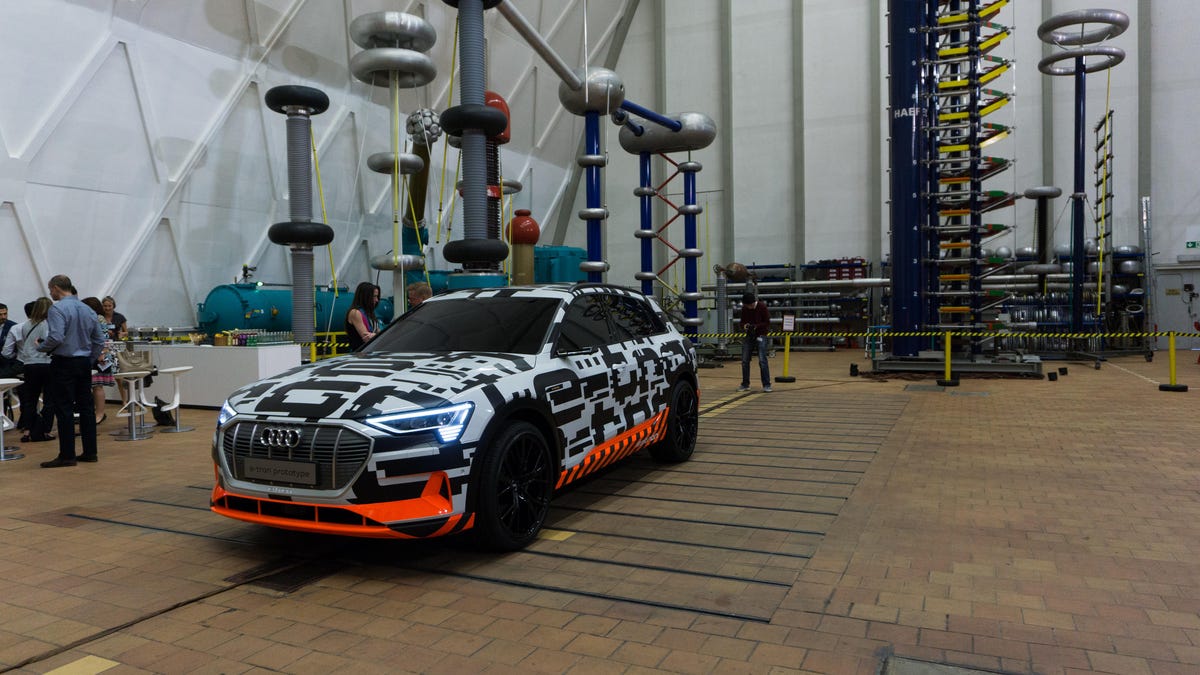How Audi’s E-Tron SUV is plugged in to battle Tesla
The performance of an EV hinges on the performance of its battery. With the 2019 E-Tron EV, Audi's going to some extraordinary lengths to show off just how much tech is packed in its pack.

At the Siemens AG facility in Berlin, Germany, inside a room full of giant machines ripped straight from a '50s sci-fi epic, Audi kicked off the demonstration of its E-Tron EV in rather dramatic fashion: By shooting it with a bolt of lightning. With a flash of blue and a suitably menacing buzz, the bolt arced into the roof of the all-electric SUV prototype, which had been otherwise minding its own business, sitting demure in its camouflage.
After the two-second zap, the car looked otherwise unfazed, headlights still bright and no signs of smoke. While closer inspection later did reveal some small burn marks on the roof, that's a pretty minor penalty for a 500 kilovolt kick. That strike, at 0.8 amps, delivered 400 kilowatts of electricity over those two seconds, a charge equivalent to just 0.2 percent of a full charge in the 95 kilowatt-hour battery pack.
In other words, even if you did live in Tornado Alley and found some way to catch a bolt of lightning, you'd still need some other means to charge your EV. Thankfully, after the simulated strike, Audi unveiled a variety of less dramatic yet far more practical charging solutions.
The E-Tron sports a rated maximum range of around 250 miles in the European cycle (the US range has not yet been established). That isn't quite world-conquering but stands ahead of nearly everyone bar Tesla. This in a car that the company calls a "fully fledged Audi." For perspective, it's roughly Q7-sized, and an awful lot bigger than a Chevrolet Bolt EV. Audi says it will also be a performance-oriented machine, and while nobody would mistake its upright silhouette for that of a sports car, remember this is the German market, where the ability to maintain terrific velocity on the Autobahn is a priority. E-Tron, Audi says, will happily do just that.
The 95 kWh pack sits in the floor of the car and is itself composed of 36 cell modules, each one containing a dozen individual, flat battery cells. Their shape offers high density within the volume of the pack while integrated liquid cooling ensures the pack's temperature stays within its so-called "feel-good range" of 25 to 35 degrees Celsius (about 75 to 95 Fahrenheit) to ensure maximal range in all conditions. Audi also explained the pack's cooling lines are kept isolated from the cells themselves, preventing commingling of coolant with battery fluid. The company claims this creates a pack less likely to burn in the case of a serious accident. The substantial aluminum castings surrounding the pack will surely help in that regard, too.
Worries about range and safety are of course hugely important, but charging is another major issue that must be conquered before people will truly begin to adopt EVs en masse. The company estimates that approximately 90 percent of all charging will take place at home, and to cover that aspect the company will offer two different chargers, depending on your electrical setup, offering either 11 kW or 22 kW, able to fully charge the car in either 8.5 or 4.5 hours.
However it's the other charging times, on the road or at the destination, that give most potential EV owners the most concern. Audi has a plan there, too. Unlike Tesla, which launched its own proprietary Supercharger network in 2012, Audi has partnered with the other Volkswagen Group brands plus Daimler, Ford, and BMW to build out a charging network across Europe called Ionity, with a planned 400 stations open by 2020.
In the US, the Volkswagen Group is building out its Electrify America network, with a planned 290 stations by the end of 2019. That service recently got a huge boost with a major partnership with Walmart. On one hand, these numbers are small compared to the 1,210 Superchargers already on the global market, but unlike Tesla's solution these new chargers will be developed on industry standards, thus helping the industry as a whole, and not just one brand.
The E-Tron's 95 kWh battery pack, which is nearly as large as a king-size bed and weighs over 1,500 pounds alone!
That standard is CCS, and the E-Tron will charge at a maximum of 150 kW at present, enough for an 80 percent charge (about 200 miles) in less than 30 minutes. Down the road, Audi hopes to move towards a 350 kW charging rate (similar to the Porsche Mission E), delivering that same 80 percent charge in just about 12 minutes.
Even beyond its own Ionity and Electrify America efforts, Audi is working to establish a single charging card and service that will work across the hundreds of different charging operators and their tens of thousands of chargers internationally.
How much will it cost to use that service? That's still a big question, as is how much will the E-Tron itself cost. For answers to those details we'll have to wait a bit longer. The full, production E-Tron is set for its unveiling later this year ahead of entering production in 2019. That will be just the beginning of what Audi calls an "electric model offensive", with the company launching 10 more electrified vehicles over the next 7 years.
To see that Audi has big goals for E-Tron, you just need to look at the details here, things like securing multiple suppliers for its battery technology. Presumably, this will ensure it won't suffer the same production bottlenecks that have hamstrung Tesla production over the years. Audi clearly plans to build -- and of course to sell -- a lot of these things. With the right combination of range, charging and pricing, it should do just that.

